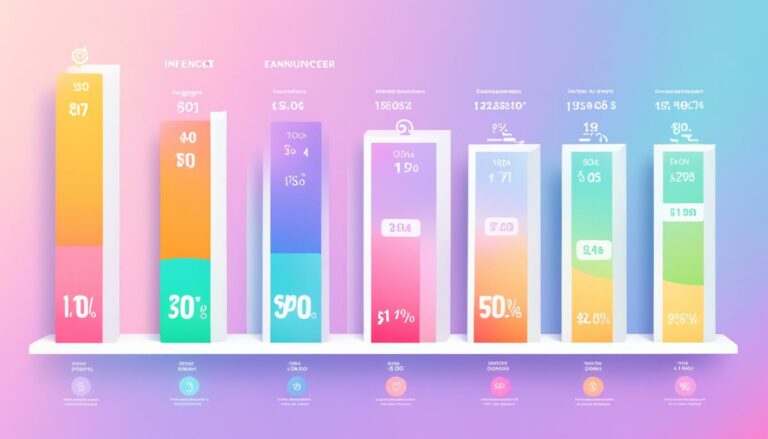Optimal Screen Time for Teens: Guide & Tips
Screen time is a concern for many parents, especially when it comes to teenagers. Finding the right balance of screen time for teens is crucial for their overall well-being. This article will provide a comprehensive guide and useful tips for managing screen time and setting healthy limits for adolescents.
Key Takeaways:
- Understanding the effects of excessive screen time on teens
- Research on recommended screen time limits for teenagers
- Signs of poor screen time balance in teens
- Tips for helping teens balance their screen time
- Screen time tools and resources for teens
Understanding the Effects of Screen Time on Teens

Excessive screen time can have a profound impact on teenagers, affecting various aspects of their well-being. Research has shown that prolonged exposure to screens can lead to detrimental effects on sleep quality, mental health, and physical health.
The Effects of Excessive Screen Time on Teens
When teens spend too much time engaged with screens, it can disrupt their sleep patterns and overall sleep quality. The blue light emitted by screens can suppress the release of melatonin, a hormone that regulates sleep. This disturbance often leads to difficulties falling asleep and can contribute to sleep deprivation.
Moreover, excessive screen time has been linked to mental health problems in teens. Long hours spent on social media and other online platforms can contribute to feelings of loneliness, anxiety, and depression. The constant exposure to idealized online personas and cyberbullying can have a significant impact on a teenager’s self-esteem and emotional well-being.
In addition, excessive screen time can lead to physical health issues. Spending extended periods in sedentary behaviors, such as sitting in front of a screen, contributes to a sedentary lifestyle. This lack of physical activity can increase the risk of obesity, cardiovascular diseases, and other health problems.
Recognizing the negative effects of excessive screen time, it is crucial for parents and caregivers to establish screen time guidelines for teenagers. By setting limits and promoting a healthy balance between screen time and other activities, parents can help safeguard their teens’ well-being.
Research has shown that excessive screen time can have detrimental effects on a teenager’s sleep quality, mental health, and physical health. By setting screen time guidelines, parents can play a crucial role in protecting their teens from these adverse effects.
Screen Time Guidelines for Teens
While there is no one-size-fits-all approach to screen time guidelines, experts recommend considering the following factors when setting limits for teenagers:
- The American Academy of Pediatrics suggests that teens should have no more than two hours of recreational screen time per day.
- Encouraging teens to take frequent breaks from screens and engage in other activities, such as physical exercise, hobbies, and social interactions.
- Promoting a healthy sleep routine by establishing a digital curfew, ensuring screens are turned off at least one hour before bedtime.
- Encouraging the use of screen time for educational and productive purposes, such as schoolwork or creative pursuits.
- Having open and ongoing conversations with teens about responsible screen time use and the potential consequences of excessive usage.
Screen Time Guidelines for Teens
| Age Group | Recommended Screen Time |
|---|---|
| 13-18 years | No more than 2 hours of recreational screen time per day |
In conclusion, understanding the effects of excessive screen time on teens is crucial for parents and caregivers. By setting screen time guidelines and promoting a balanced lifestyle, parents can help mitigate the negative impacts and support their teens’ overall well-being.
Research on Teens’ Screen Time
Understanding the effects of screen time on teenagers is essential for parents and caregivers. Fortunately, numerous studies have been conducted to shed light on this subject. These research findings provide valuable insights into the recommended screen time limits for teens and emphasize the significance of achieving a healthy balance between screen time and other activities.
“Research has shown that excessive screen time can have detrimental effects on teenagers’ mental and physical well-being.”
One notable study conducted by the American Academy of Pediatrics suggests that teenagers should aim for no more than two hours of recreational screen time each day. This includes activities such as social media, gaming, and streaming videos. By following these guidelines, teens can better prioritize other important aspects of their lives, such as schoolwork, physical activities, and social interactions.
The Importance of Balancing Screen Time
Research consistently highlights the importance of balancing screen time with other activities for teenagers. Excessive screen time has been linked to various negative outcomes, including:
- Decreased physical activity levels
- Poor sleep quality
- Mental health issues, such as depression and anxiety
- Reduced academic performance
To illustrate the impact of excessive screen time on teens, consider the following statistics:
| Statistic | Percentage of Affected Teens |
|---|---|
| Teens who report insufficient sleep due to screen time | 67% |
| Teens who experience symptoms of anxiety related to excessive screen time | 53% |
| Teens who struggle with maintaining a healthy weight due to excessive screen time | 40% |
This data underscores the need for parents and caregivers to be proactive in setting appropriate screen time limits and encouraging a balanced lifestyle for their teenagers.
Recognizing the importance of research-backed recommendations, it is crucial for parents to remain informed and adaptable to the evolving landscape of technology and its impact on teens. By implementing strategies that promote a healthy balance between screen time and other activities, parents can support their teens’ overall well-being and help them develop responsible digital habits.
Signs of Poor Screen Time Balance in Teens

As a parent, it is crucial to be aware of the signs that indicate poor screen time balance in your teenagers. Recognizing these signs can help you set appropriate screen time limits and promote a healthier lifestyle for your teens. Here are some common indicators that your teen may have an imbalance in their screen time:
- Increased Anxiety or Stress: Excessive screen time can contribute to heightened levels of anxiety or stress in teenagers. If you notice your teen becoming more anxious or stressed, it may be a sign that their screen time is negatively affecting their well-being.
- Lack of Sleep: Poor screen time balance can disrupt your teen’s sleep patterns. If your teen is having difficulty falling asleep or staying asleep, excessive screen time may be the culprit.
- Limited Physical Activity: Spending too much time in front of screens can lead to a sedentary lifestyle. If your teen is not engaging in regular physical activity or showing a lack of interest in outdoor activities, it may be a sign that their screen time is overpowering other important aspects of their life.
- Distancing Themselves from Offline Social Interactions: Excessive screen time can cause teens to withdraw from face-to-face social interactions. If your teen is consistently opting for online interactions over offline ones, it may be an indication that their screen time is negatively impacting their social development.
By being attentive to these signs, you can take proactive steps towards finding the right balance of screen time for your teenagers. Establishing healthy screen time limits and encouraging a balanced lifestyle will contribute to their overall well-being, both online and offline.
Tips for Helping Teens Balance Screen Time

Managing screen time for teens is essential for their digital well-being. As a parent, you play a crucial role in helping your teenager find the right balance. Here are some practical tips and strategies to assist you in promoting healthy screen habits:
Set Rules and Boundaries
Establish clear guidelines regarding screen time usage. Create specific rules such as no screens during mealtime or before completing homework. Setting expectations and boundaries helps your teen understand the importance of balance and self-regulation.
Encourage Breaks and Physical Activity
Encourage your teen to take regular breaks from screens. Encourage them to engage in physical activities, spend time outdoors, or pursue hobbies that don’t involve screens. Physical activity promotes overall well-being and reduces the negative effects of extended screen use.
Engage in Open Discussions
Initiate open discussions with your teenager about screen time. Encourage them to share their thoughts, concerns, and challenges related to their digital habits. This creates a safe space for them to express themselves and allows you to provide guidance and support.
Provide Resources and Support
Offer resources and support to help your teen manage their digital well-being. Share educational materials, books, or articles that address topics like healthy screen habits, online safety, and responsible internet use. Additionally, consider downloading screen time management apps or software that can help monitor and limit their screen time.
Remember, every teenager is unique, and what works for one may not work for another. The key is to find a balance that suits your teen’s individual needs and promotes their overall well-being. By implementing these strategies, you can effectively support your teenager in managing their screen time and fostering a healthy digital lifestyle.
| Effective Tips for Managing Screen Time | Benefits |
|---|---|
| Set clear rules and boundaries | Teaches responsibility and self-regulation |
| Encourage breaks and physical activity | Promotes physical and mental health |
| Engage in open discussions | Builds trust and understanding |
| Provide resources and support | Assists in managing digital well-being |
Screen Time Tools and Resources for Teens

Managing screen time for teens can be challenging, but there are various tools and resources available to help both parents and teenagers find a healthy balance. These tools and resources not only enable teens to track and manage their screen usage but also provide guidance on developing healthy screen habits and promoting digital well-being.
One valuable tool is the availability of specific apps and features on devices that allow teenagers to monitor their screen time. These apps often provide data on usage patterns, set time limits, and send alerts when screen time restrictions are exceeded. By utilizing these tools, teens can gain awareness of their screen time habits and make informed decisions about their usage.
In addition to the apps and features on devices, there are also online resources and educational materials that provide valuable guidance on managing screen time for teens. These resources offer tips and strategies for setting healthy boundaries, balancing screen time with other activities, and fostering a positive digital lifestyle. They can be an excellent source of information and support for both parents and teenagers navigating the challenges of screen time management.
“By utilizing screen time tools and resources, teens can take control of their digital habits and develop a healthier relationship with screens.”
It is important for parents to actively engage with their teenagers and explore these tools and resources together. This collaborative approach can foster open communication, empower teens to make responsible choices, and ensure that screen time restrictions align with the family’s values and goals. Parents can also use these resources to educate themselves on the latest research and recommendations surrounding screen time for teens.
By combining the use of screen time tools and resources with ongoing communication and support, parents can help teenagers develop the necessary skills to manage their screen time effectively and prioritize other important aspects of their lives. It is crucial to remember that these tools are not meant to completely restrict screen time but rather to encourage responsible and mindful usage.
Comparison of Screen Time Management Tools for Teens
| Screen Time Tool | Features | Compatibility |
|---|---|---|
| Screen Time Parental Control | Time limits, app blocking, usage reports | iOS, Android |
| Family Link | App and content restrictions, time limits, location tracking | iOS, Android |
| Digital Wellbeing | Screen time tracking, app timers, focus mode | Android |
| OurPact | Screen time schedules, blocking internet and apps | iOS, Android |
| Screenagers | Screen time challenges, tips for healthy screen habits | Web-based |
As seen in the table above, there are several screen time management tools available for parents and teens to explore. From comprehensive parental control apps to educational web-based platforms, these tools offer a range of features catered to different needs and preferences. It may be beneficial for parents to discuss these options with their teens and select a tool that aligns with the family’s goals for managing screen time.
By utilizing screen time tools and resources, teens can take control of their digital habits and develop a healthier relationship with screens. These resources, combined with parental guidance and ongoing communication, can contribute to a balanced and mindful approach to screen time management for teenagers.
The Importance of Active Screen Time
It’s important to recognize that not all screen time is created equal. Encouraging teens to engage in active screen time can have more positive effects on their development compared to passive screen time. Active screen time involves creating content or participating in interactive educational activities, which can stimulate creativity, critical thinking, and social engagement.
Setting limits on passive screen time, such as mindless scrolling or binge-watching, is crucial for maintaining a healthy balance. Excessive passive screen time can lead to sedentary behavior, reduced physical activity, and potential negative impacts on mental well-being. By encouraging active screen time and limiting passive screen time, parents can help their teens make the most of their digital experiences.
“Active screen time allows teens to actively engage with technology and use it as a tool for learning, creativity, and self-expression.”
Active screen time can take various forms, such as:
- Creating and editing videos
- Participating in online workshops or educational programs
- Exploring coding or programming
- Engaging in online collaborative projects
- Playing interactive educational games
By encouraging teens to explore these types of activities, parents can help them develop valuable skills and expand their interests in a meaningful way.
| Benefits of Active Screen Time | How to Encourage Active Screen Time |
|---|---|
|
|
By balancing passive screen time with active screen time and providing resources for meaningful digital activities, parents can help their teens develop a healthy relationship with technology while maximizing its potential benefits.
The Role of Parents in Managing Teen Screen Time
Parents play a crucial role in guiding and monitoring their teenagers’ screen time to mitigate the effects of excessive screen time on teens. By setting clear boundaries, modeling healthy screen habits, and fostering open communication, parents can help their teens develop responsible digital behavior and maintain a healthy balance between screens and other activities.
One of the most effective strategies is to establish screen time limits for adolescents. By implementing these limits, parents can help reduce the negative impacts of excessive screen time on their teens’ well-being.
Setting Clear Boundaries
Creating consistent rules and boundaries around screen time is essential. This ensures that teens understand the expectations and have a framework for managing their digital habits. Parents can discuss and set limits on the duration and specific times of screen use, promoting a healthier balance with other activities.
“Our family has established a no-screen policy during mealtimes and two hours before bedtime. This encourages quality family time and guarantees a good night’s sleep for our teen.”
Modeling Healthy Screen Habits
Parents need to lead by example and demonstrate responsible screen use. By being mindful of their own screen time and practicing good digital habits, parents can provide a positive influence on their teens.
“I make a conscious effort to limit my screen time and engage in activities that don’t involve screens. This sets an example for my teen and shows them the importance of finding a balance.”
Fostering Open Communication
Encouraging open and honest conversations about screen time can help teens understand the potential effects of excessive use. By discussing the importance of managing screen time and addressing any concerns, parents can create a supportive environment where teens feel comfortable opening up about their struggles and seeking guidance.
“We regularly have family discussions about screen time, sharing our experiences and challenges. This helps us understand each other’s perspectives and find solutions together.”
By actively engaging in their teen’s screen time management, parents can have a positive impact on their well-being and digital habits.
Tips for Parents:
- Set clear and consistent screen time limits for adolescents.
- Be a role model for healthy screen habits.
- Encourage open communication about screen time.
- Monitor and track your teen’s screen usage.
- Provide alternative activities and encourage offline interactions.
The Impact of Persuasive Design on Teen Screen Time
Tech companies employ persuasive design techniques that can significantly influence the screen time behaviors of teenagers. These techniques are aimed at creating addictive experiences, making it challenging for teens to resist the allure of certain apps and platforms. As a result, finding a balance between enjoyable screen activities and other aspects of their lives becomes increasingly important.
Parents play a crucial role in helping their teenagers navigate the persuasive design tactics employed by technology companies. By being aware of these influences, parents can better understand their teens’ screen time habits and provide the necessary support and guidance to help them establish a healthy balance.
“Technology is designed to hijack kids’ attention and keep them hooked for as long as possible. As parents, we need to be vigilant and proactive in addressing the persuasive nature of certain apps and platforms.”
– Dr. Sarah Thompson, Child Psychologist
The Influence of Persuasive Design on Teenagers
Persuasive design techniques capitalize on psychological principles to foster addictive and engaging experiences. These techniques include:
- Variable Rewards: Apps and platforms use unpredictable rewards to create anticipation and encourage continued use.
- Social Validation: Features like likes, comments, and followers provide social validation, tapping into the need for acceptance and belonging.
- Endless Scroll: Infinite scrolling feeds an endless stream of content, making it difficult for teens to disengage.
- Auto-Play: Content that automatically plays one after the other keeps users hooked, consuming more screen time than intended.
By implementing these strategic design elements, technology companies strive to maximize user engagement and ultimately generate revenue. However, they can inadvertently lead to excessive screen time and unhealthy habits among teenagers.
Supporting Teens in Balancing Screen Time
Parents can support their teens in finding a balance between screen time and other activities by:
- Open Communication: Engage in ongoing conversations to understand their motivations, challenges, and concerns regarding screen time.
- Setting Boundaries: Establish clear guidelines for screen time, including time restrictions and designated screen-free zones.
- Encouraging Offline Activities: Help teens explore and engage in non-screen activities such as hobbies, sports, and social interactions.
- Teaching Digital Literacy: Educate teens about persuasive design tactics used by tech companies, empowering them to make informed decisions.
By equipping teens with the knowledge and skills to navigate persuasive design, parents can guide them towards a healthy and balanced approach to screen time.
Awareness is Key
Being aware of the techniques employed by tech companies empowers parents to take proactive measures in managing their teen’s screen time. By staying informed and engaged, parents can advocate for their teens’ well-being, ensuring a healthy balance between digital experiences and other important aspects of their lives.
| Persuasive Design Techniques | Examples |
|---|---|
| Variable Rewards | Notification alerts, surprise bonuses, in-app prizes |
| Social Validation | Likes, comments, followers, social comparisons |
| Endless Scroll | Infinite feeds, suggested content, autoplaying videos |
| Auto-Play | Automatically playing videos, next episode previews |
Addressing Concerns About Myopia and Eye Health
Excessive screen time has been found to have detrimental effects on teenagers’ eye health, including the development of myopia and other related issues. It is crucial for parents to be aware of these potential risks and take proactive steps to protect their teen’s eyes.
One effective measure is implementing the elbow rule. This rule suggests maintaining a distance of at least an arm’s length between the screen and the eyes. It helps reduce eye strain and minimizes the risk of developing myopia.
Another helpful guideline is the 20/20 rule. Encourage teenagers to take a break from screen time every 20 minutes and focus their gaze on an object at least 20 feet away for 20 seconds. This practice can alleviate eye fatigue and promote better eye health.
“Taking regular breaks from screen time and focusing on distant objects revitalizes the eyes and reduces the strain caused by prolonged close-up screen viewing.” – Dr. Lisa Johnson, Ophthalmologist
In addition to these rules, limiting screen time before bed can also contribute to healthier eyes and better sleep quality for teenagers. The blue light emitted from screens can disrupt the body’s natural circadian rhythm, making it harder for teens to fall asleep. Encourage teens to avoid screen use at least one hour before bedtime to improve their overall sleep patterns and promote optimal eye health.
| Eye Health Tips for Teens |
|---|
| Follow the elbow rule: Maintain a proper distance between the screen and the eyes. |
| Practice the 20/20 rule: Take regular breaks and focus on distant objects. |
| Avoid screen time before bed: Limit the use of screens at least one hour before sleeping. |
| Eat eye-healthy foods: Incorporate foods rich in vitamin A, C, and E, as well as omega-3 fatty acids. |
| Visit an eye care professional: Schedule regular eye exams to monitor eye health. |
By implementing these measures, parents can help safeguard their teenager’s eye health and mitigate the potential risks associated with excessive screen time.
Promoting a Healthy Digital Lifestyle for Teens
When it comes to teens’ well-being in the digital age, managing screen time is just one piece of the puzzle. Promoting a healthy digital lifestyle for teenagers involves equipping them with the necessary digital literacy skills, fostering responsible online behavior, and creating a positive online environment.
Teaching teens digital literacy skills empowers them to navigate the digital world with confidence and critical thinking. By helping them understand concepts like online privacy, cyberbullying, and digital footprints, parents can arm their teens with the knowledge to make informed decisions online.
Furthermore, promoting responsible online behavior is essential for teens’ digital well-being. Encouraging empathy, respect, and kindness in their online interactions can help create a positive online environment. It’s important for teens to be mindful of their own digital footprint and consider the impact their words and actions may have on others.
Parents can also play a key role in fostering a positive online environment by actively engaging with their teens’ online activities. By participating in discussions about their favorite apps, social media platforms, and online communities, parents can gain insight into their teens’ digital experiences and provide guidance when needed.
“A healthy digital lifestyle for teens involves equipping them with digital literacy skills, fostering responsible online behavior, and promoting a positive online environment.”
“The digital world can be both exciting and challenging for teenagers. As parents, it’s crucial to guide them in developing healthy digital habits and making positive choices online. By nurturing their digital well-being, we can help them navigate the online realm with confidence and resilience.”
– Dr. Emily Thompson, Child Psychologist
Creating a Family Media Plan
One effective way to promote a healthy digital lifestyle for teens is by creating a family media plan. This plan can include guidelines and agreements on screen time limits, appropriate content, and digital device usage. By involving teens in the process and allowing them to contribute to the plan, they will feel a sense of ownership and responsibility for their digital habits.
Here are some key elements to consider when creating a family media plan:
- Set clear screen time limits for adolescents, considering their age, developmental stage, and individual needs.
- Agree on designated screen-free zones and times, such as during meals or before bedtime.
- Encourage a balanced digital lifestyle by setting aside time for physical activities, hobbies, and face-to-face interactions.
- Discuss guidelines for accessing and sharing personal information online to ensure online privacy and safety.
- Establish rules for respectful online communication and address cyberbullying or other online conflicts promptly.
By implementing a family media plan, parents can provide a structure that supports teens’ digital well-being while ensuring a healthy relationship with technology.
Remember, promoting a healthy digital lifestyle for teens involves more than just managing screen time. It requires a holistic approach that encompasses digital literacy, responsible behavior, and a positive online environment. By actively engaging with your teens and creating a family media plan, you can help them develop the skills and mindset necessary to navigate the digital world safely and confidently.
Conclusion
Finding the optimal balance of screen time for teens is crucial for their overall well-being. The effects of excessive screen time on teenagers can be detrimental to their mental and physical health. However, by implementing the tips and strategies discussed in this article, parents can effectively manage screen time for their teens and promote a healthy digital lifestyle.
Parents play a vital role in managing their teen’s screen time by setting clear boundaries, modeling healthy screen habits, and fostering open communication. Additionally, encouraging active screen time, such as engaging in educational activities or creating content, can have more positive effects on teenagers.
It’s important to remember that managing screen time is an ongoing process that requires active involvement from both parents and teens. By working together, parents can support their teens’ well-being and help them develop healthy digital habits that will benefit them in the long run. With the right approach, optimal screen time for teens can be achieved, ensuring a balanced and fulfilling offline and online life.
FAQ
How much screen time is recommended for teenagers?
There is no specific time limit that applies to all teenagers. However, the American Academy of Pediatrics recommends no more than 2 hours of recreational screen time per day for teenagers.
What are the effects of excessive screen time on teens?
Excessive screen time can lead to poor sleep quality, mental health problems, and physical health issues in teenagers.
How can parents recognize poor screen time balance in teens?
Signs of poor screen time balance in teens may include increased anxiety or stress, lack of sleep, limited physical activity, and distancing themselves from offline social interactions.
What strategies can parents use to help teens balance their screen time?
Parents can help teens balance their screen time by setting rules and boundaries, encouraging breaks and physical activity, engaging in open discussions about screen time, and providing resources and support for managing digital well-being.
Are there tools and resources available to help teens manage their screen time?
Yes, there are various apps and features on devices that allow teens to track their usage, set time limits, and receive alerts. Additionally, there are online resources and educational materials that provide guidance on healthy screen habits and digital well-being.
What is active screen time and why is it important?
Active screen time refers to engaging in activities that require interaction and participation, such as creating content or participating in interactive educational activities. It is important because it can have more positive effects on teenagers’ development compared to passive screen time.
What is the role of parents in managing teen screen time?
Parents play a crucial role in managing their teen’s screen time by setting clear boundaries, modeling healthy screen habits, and fostering open communication.
How does persuasive design influence teen screen time behaviors?
Persuasive design techniques used by technology companies can influence teen screen time behaviors, making it challenging for teens to resist the addictive nature of certain apps and platforms.
Are there any eye health concerns related to excessive screen time in teens?
Excessive screen time has been linked to myopia development and other eye health issues in teenagers. Parents should be aware of the potential risks and take steps to protect their teen’s eye health.
How can a healthy digital lifestyle be promoted for teens?
Promoting a healthy digital lifestyle for teens involves teaching them digital literacy skills, promoting responsible online behavior, and fostering a positive online environment.







